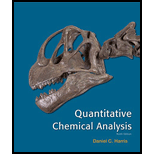
(a)
Interpretation:
Average oxidation numbers of Bismuth and Copper in the superconductor and the oxygen stoichiometry coefficient has to be found.
Concept introduction:
Oxidation number: Oxidation number is defined as degree of oxidation (ie. loss of an electrons) of an atom within the chemical compound.
There is slightly difference between oxidation state and oxidation number. In oxidation state, there is electronegativity of an atom in a bond should be considered. However, when describing oxidation number, electronegativity does not considered.
(a)
Answer to Problem 16.37P
Average oxidation number of Bi and copper are found to be
Explanation of Solution
To calculate: Average oxidation number of Bi and copper
Experiment A:
Amount of initial copper ion is
Experiment B:
Amount of initial
Normalizing to one gram of super conductor =
Experiment A:
Experiment B:
It is easier not to get missing the arithmetic if that oxidized Bismuth is
So, rewrite these previous equation as
Equation (2) has to be subtracted from equation (1), we get
Equation (2) and (3) shows that the relationship in the formula of the superconductor is
One gram of superconductor contains

Substituting 
Average oxidation number of Bi is
(b)
Interpretation:
The uncertainties in the oxidation number and x when the quantities in Experiment A are
(b)
Explanation of Solution
To found: The uncertainties in the oxidation number and x when given quantities in experiment A and experiment B
Experiment A: Consumption of
Experiment B: Consumption of
Normalising to one gram of superconductor gives,
Experiment A: 
Experiment B: 
The relative uncertainty in b given as 
The average oxidation number of Bi is given as
Want to see more full solutions like this?
Chapter 16 Solutions
Quantitative Chemical Analysis
- Don't USE AIarrow_forwardShow the full mechanism of how the molecule ((1E, 3E, 5E)-1-methoxyhepta-1,3,5-triene) is built using substitution and elimination reactions. You can start with an alkane of any carbon length with any number of leaving groups attached or with a alkoxide of any carbon length (conjugate base of an alcohol). Show each step and and explanation for each reaction. Also include why the reagents and solvents were picked and what other products can be expected.arrow_forwardProblems 1. Acids (11) and (12) were both made by Grignard addition to CO2 rather than by cyanide displacement (p T 80). Why? (11) -CO2H MeO- (12) CO,Harrow_forward
 ChemistryChemistryISBN:9781305957404Author:Steven S. Zumdahl, Susan A. Zumdahl, Donald J. DeCostePublisher:Cengage Learning
ChemistryChemistryISBN:9781305957404Author:Steven S. Zumdahl, Susan A. Zumdahl, Donald J. DeCostePublisher:Cengage Learning ChemistryChemistryISBN:9781259911156Author:Raymond Chang Dr., Jason Overby ProfessorPublisher:McGraw-Hill Education
ChemistryChemistryISBN:9781259911156Author:Raymond Chang Dr., Jason Overby ProfessorPublisher:McGraw-Hill Education Principles of Instrumental AnalysisChemistryISBN:9781305577213Author:Douglas A. Skoog, F. James Holler, Stanley R. CrouchPublisher:Cengage Learning
Principles of Instrumental AnalysisChemistryISBN:9781305577213Author:Douglas A. Skoog, F. James Holler, Stanley R. CrouchPublisher:Cengage Learning Organic ChemistryChemistryISBN:9780078021558Author:Janice Gorzynski Smith Dr.Publisher:McGraw-Hill Education
Organic ChemistryChemistryISBN:9780078021558Author:Janice Gorzynski Smith Dr.Publisher:McGraw-Hill Education Chemistry: Principles and ReactionsChemistryISBN:9781305079373Author:William L. Masterton, Cecile N. HurleyPublisher:Cengage Learning
Chemistry: Principles and ReactionsChemistryISBN:9781305079373Author:William L. Masterton, Cecile N. HurleyPublisher:Cengage Learning Elementary Principles of Chemical Processes, Bind...ChemistryISBN:9781118431221Author:Richard M. Felder, Ronald W. Rousseau, Lisa G. BullardPublisher:WILEY
Elementary Principles of Chemical Processes, Bind...ChemistryISBN:9781118431221Author:Richard M. Felder, Ronald W. Rousseau, Lisa G. BullardPublisher:WILEY





